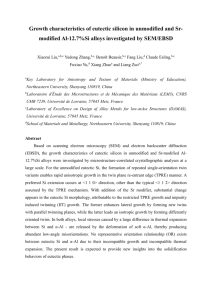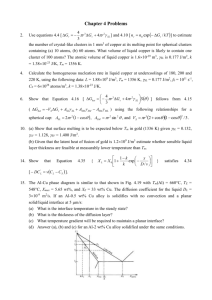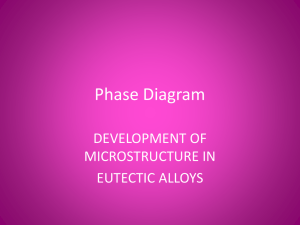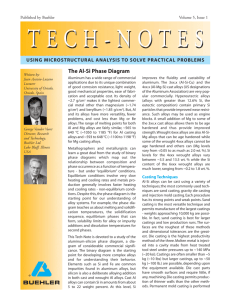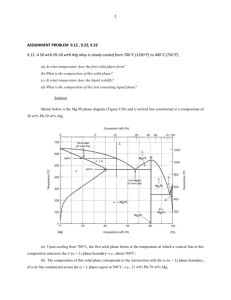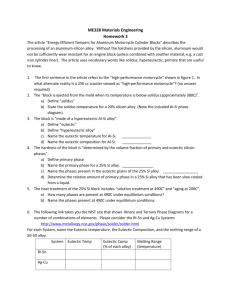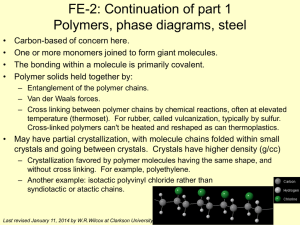The Aluminum-Silicon Phase Diagram and Eutectic
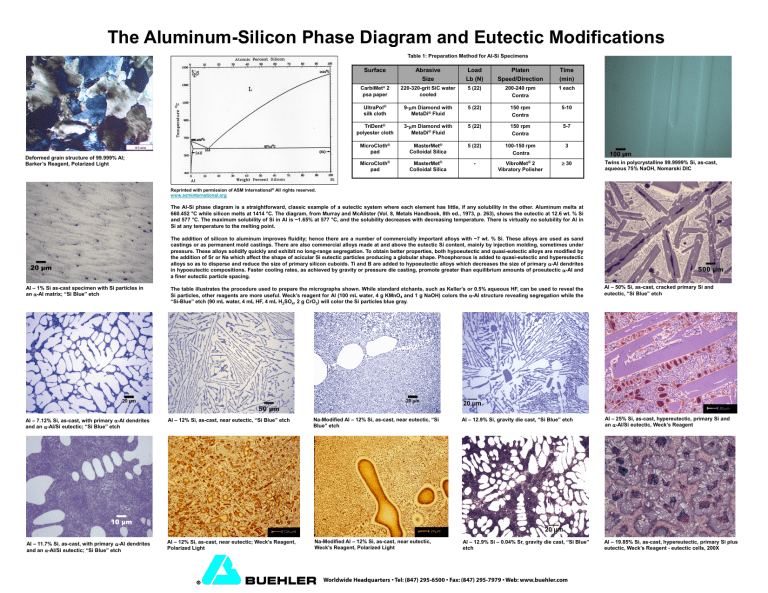
The Aluminum-Silicon Phase Diagram and Eutectic Modifications
Table 1: Preparation Method for Al-Si Specimens
Deformed grain structure of 99.999% Al;
Barker’s Reagent, Polarized Light
Surface
CarbiMet ® 2 psa paper
UltraPol ® silk cloth
TriDent ® polyester cloth
Abrasive
Size
220-320-grit SiC water cooled
9μ m Diamond with
MetaDi ® Fluid
3μ m Diamond with
MetaDi ® Fluid
MicroCloth ® pad
MicroCloth ® pad
MasterMet ®
Colloidal Silica
MasterMet ®
Colloidal Silica
Load
Lb (N)
5 (22)
5 (22)
5 (22)
5 (22)
-
Platen
Speed/Direction
200-240 rpm
Contra
150 rpm
Contra
150 rpm
Contra
100-150 rpm
Contra
VibroMet ® 2
Vibratory Polisher
Time
(min)
1 each
5-10
5-7
3
≥ 30 Twins in polycrystalline 99.9999% Si, as-cast, aqueous 75% NaOH, Nomarski DIC
Al – 1% Si as-cast specimen with Si particles in an α -Al matrix; “Si Blue” etch
Reprinted with permission of ASM International ® www.asminternational.org
All rights reserved.
The Al-Si phase diagram is a straightforward, classic example of a eutectic system where each element has little, if any solubility in the other. Aluminum melts at
660.452 °C while silicon melts at 1414 °C. The diagram, from Murray and McAlister (Vol. 8, Metals Handbook, 8th ed., 1973, p. 263), shows the eutectic at 12.6 wt. % Si and 577 °C. The maximum solubility of Si in Al is ~1.65% at 577 °C, and the solubility decreases with decreasing temperature. There is virtually no solubility for Al in
Si at any temperature to the melting point.
The addition of silicon to aluminum improves fluidity; hence there are a number of commercially important alloys with ~7 wt. % Si. These alloys are used as sand castings or as permanent mold castings. There are also commercial alloys made at and above the eutectic Si content, mainly by injection molding, sometimes under pressure. These alloys solidify quickly and exhibit no long-range segregation. To obtain better properties, both hypoeutectic and quasi-eutectic alloys are modified by the addition of Sr or Na which affect the shape of acicular Si eutectic particles producing a globular shape. Phosphorous is added to quasi-eutectic and hypereutectic alloys so as to disperse and reduce the size of primary silicon cuboids. Ti and B are added to hypoeutectic alloys which decreases the size of primary α -Al dendrites in hypoeutectic compositions. Faster cooling rates, as achieved by gravity or pressure die casting, promote greater than equilibrium amounts of proeutectic α -Al and a finer eutectic particle spacing.
The table illustrates the procedure used to prepare the micrographs shown. While standard etchants, such as Keller’s or 0.5% aqueous HF, can be used to reveal the
Si particles, other reagents are more useful. Weck’s reagent for Al (100 mL water, 4 g KMnO
“Si-Blue” etch (90 mL water, 4 mL HF, 4 mL H
2
SO
4
, 2 g CrO
3
4 and 1 g NaOH) colors the α -Al structure revealing segregation while the
) will color the Si particles blue gray.
Al – 50% Si, as-cast, cracked primary Si and eutectic, “Si Blue” etch
Al – 7.12% Si, as-cast, with primary α -Al dendrites and an α -Al/Si eutectic; “Si Blue” etch
Al – 12% Si, as-cast, near eutectic, “Si Blue” etch Na-Modified Al – 12% Si, as-cast, near eutectic, “Si
Blue” etch
Al – 12.9% Si, gravity die cast, “Si Blue” etch Al – 25% Si, as-cast, hypereutectic, primary Si and an α -Al/Si eutectic, Weck’s Reagent
Al – 11.7% Si, as-cast, with primary α -Al dendrites and an α -Al/Si eutectic; “Si Blue” etch
Al – 12% Si, as-cast, near eutectic; Weck’s Reagent,
Polarized Light
Na-Modified Al – 12% Si, as-cast, near eutectic,
Weck’s Reagent, Polarized Light
Al – 12.9% Si – 0.04% Sr, gravity die cast, “Si Blue” etch
Al – 19.85% Si, as-cast, hypereutectic, primary Si plus eutectic, Weck’s Reagent - eutectic cells, 200X
